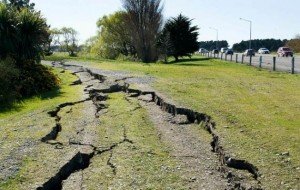As the land beneath Christchurch continues to shake due to ongoing aftershocks, residents are are seeking answers from the experts.
 In an ‘ask an expert’ article published today on the Press website, reader’s questions such as “why so many aftershocks?” are put to scientists from GNS.
In an ‘ask an expert’ article published today on the Press website, reader’s questions such as “why so many aftershocks?” are put to scientists from GNS.
An excerpt (read the full article here):
Ask an Expert: why so many aftershocks?
As of early June, Haiti had experienced 42 aftershocks, Japan 726 aftershocks and Canterbury over 7000 aftershocks. Is there any recording, worldwide, of as many aftershocks as this? Is this related to volcanic activity? – R Brown and G Symes (separately).
The discrepancy in the number of earthquakes is related to the density of the seismic network (ie, the number of seismic instruments) and the location of the earthquakes relative to the seismic network. The Canterbury region has a very dense seismic network and the Canterbury earthquakes are located close to the instruments. Therefore, it is possible for us to locate a great many earthquakes with small magnitudes. In Haiti, the seismic network is very poor and only larger earthquakes (generally magnitude 4.0 and larger) can be located. In Japan, the seismic network is very dense. However, the great Japanese earthquake happened off the coast of Japan, some distance away from the seismic instruments, so once again it is only possible to locate the larger earthquakes.
If Haiti had a similar seismic network to New Zealand, the number of recorded earthquakes would be similar to the Canterbury region. And if the Japanese earthquake had occurred onshore – closer to the seismic instruments – there would be many more earthquakes recorded than in Canterbury. There is no indication that the Canterbury earthquakes are related to volcanic activity. – Dr John Ristau, GNS Science seismologist.
Can you please provide a street map showing the faults so we can plainly see exactly where they begin and end. Can we have the aftershock history of the individual faults (how many) or if, in fact, they have or have not yet been active. This would give a better indication of how each fault is behaving. – Tracey.
We understand your interest in knowing the precise location and activity rate of the faults that underlie Christchurch City. However, the answer is not so simple in that neither the Port Hills Fault nor a possible fault through the southern part of the city associated with the Boxing Day sequence of earthquakes come to the surface. Also, we have only the locations of a dozen or so earthquakes and two lines of deep soundings to go on this. This is not enough to confirm the length or continuity of the fault. Therefore, it is not possible to provide their location at street-level detail. – Dr Kelvin Berryman, Natural Hazards Research Platform manager, GNS Science
Are all these earthquakes triggered by tectonic plate movement in the first place; ie, Pacific plate pushing against the Australian plate? – Noel.
You are correct that the sequence of earthquakes in Canterbury is 100 per cent tectonic in nature. GPS measurements tell us that the Pacific and Australian tectonic plates are converging obliquely at 38 millimetres a year through the centre of the South Island. This produces an inexorable straining in the brittle crust across the South Island. – John Callan, GNS Science communications manager.